
Music Theory for Guitar Workbook Series: Interview with Amy Hite
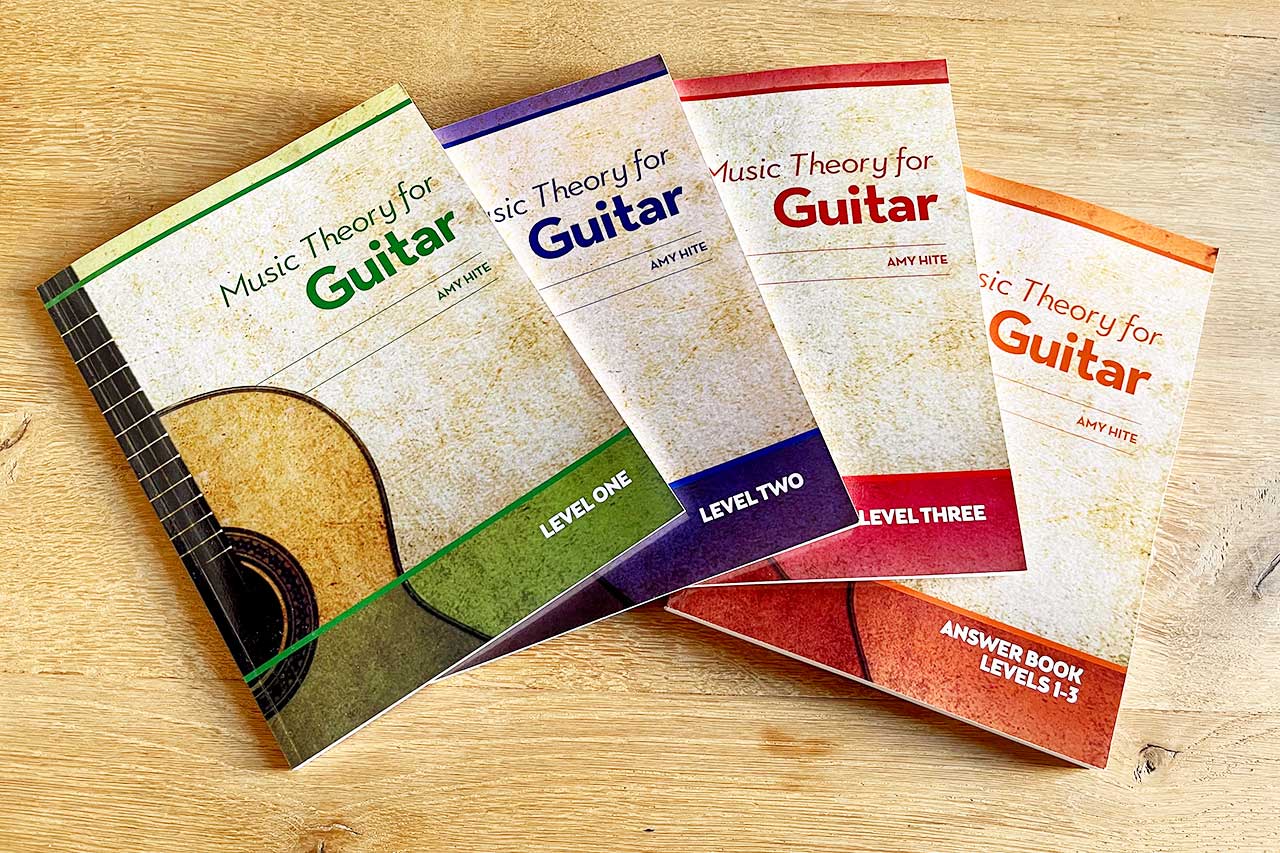
Music Theory for Guitar Workbook Series: Interview with Amy Hite
Music Theory for Guitar Workbook Series: Interview with Amy Hite
Hello Amy,
First of all, we are delighted to have discovered you through your subscription on Luthiers.com. We are very happy to highlight your series of music theory learning books for guitarists, because behind the luthiers’ instruments, it is always useful to have good working methods to fully enjoy your instrument.
Music Theory for Guitar Workbook Series: Interview with Amy Hite
Before talking about the content of your methods, can you introduce yourself and tell us about your background?
I’m a classical guitar and Alexander Technique teacher from California.
I earned my Masters Degree in Classical Guitar Performance from California State University, Fullerton, where I studied under the tutelage of David Grimes. I have been teaching classical guitar since 2005.
I was the chair of the Guitar Syllabus Committee with the Music Teachers Association of California during the creation of the Certificate of Merit™ program for classical guitar. While building this curriculum, I learned a lot about teaching theory at incremental levels. I saw the benefits in my own students from practicing written theory at home every week to prepare for the theory exam included in Certificate of Merit. I found that when students had repetition of note naming, rhythm exercises, fretboard theory, and so on, they remembered things better in their lessons and thus could learn their pieces and scales faster and more accurately.
This inspired me to create the theory workbooks.
What type of musical training / school curriculum did you follow? Did you start playing the instrument at a very young age? Did you come from a family of musicians?
I started playing the piano at age six and the guitar at age nine.
I always loved music. When I took up the guitar, I started with basic chords and moved on to a method book where I learned to read music and play melody. My teacher at the time introduced me to many different styles of guitar, one which was classical. I really took to the nuances and intricacies of the classical guitar.
I’m the first musician in my family, but funny enough, my younger cousin has now followed in my footsteps as a professional percussionist and school band teacher. My sister also teaches piano lessons, although she never played professionally.
We have read with great attention the 3 volumes of your method, they are extremely well done. The organization is very clear, and the flow of each volume follows a very well thought-out logic. How did you prepare this? Did you base it on your personal learning experience?
I based the workbooks on what I found myself teaching most to my own students and what seemed necessary for them to learn in order to grow as a whole musician and not just someone who could play a few songs on the guitar. I took things apart from the ground up. I want my students not just to remember that a quarter note receives one beat in 4/4 time, but I wanted them to have to recall that over and over again and apply it to music in different ways, such as writing in counting with different music examples, adding missing notes to a measure, and such. If you ever took a music theory class in high school or college, you might remember the repetition that was involved. Our guitar students need that same kind of repetition to have a thorough understanding of what it is they are playing. I had to make a lot of decisions along the way as to when something should be introduced, what to include and what not to include, etc. I asked for guidance on the curriculum from colleagues on this as I find it’s always helpful to get an outsider’s perspective when you’re into your own creative project in a deep way.
The workbooks were really my Covid project.
When the world shut down, I found myself with extra time. I woke up at 4:00 AM seven days a week for a year and a half to get the work done before my teaching day began. It took a lot of patience and tedious work at the computer, but there was also the fun creative aspect of it all. I used my students as guinea pigs with the exercises and tweaked things along the way. I received technical help from a music editing expert who helped me with some of the formatting and images to keep me from going crazy with the technology aspect of it all!
Music Theory for Guitar Workbook Series: Interview with Amy Hite
We’ll talk about this in more detail later, but one thing we thought was really great is that in addition to your 3 volumes, you offer an “answer book” that includes the results of all the exercises in each volume. This is a great idea, congratulations! It reminded us of our “vacation notebooks” when we were children.
So your method series is for adults as well as for children? And, with this “answer book”, parents who are not necessarily confirmed musicians, can also help their children to follow their progress. Did you make this “answer book” for that? Or, to allow the student, even an adult, to have a perfect autonomy by studying with the different volumes of your method?
I wanted the workbooks to be written in a way that was accessible to children but also appropriate for adult learners.
The answer book could be helpful for parents helping their children and adult learners using the workbooks for self-study as you mentioned, as well as for teachers who might want to correct things quickly.
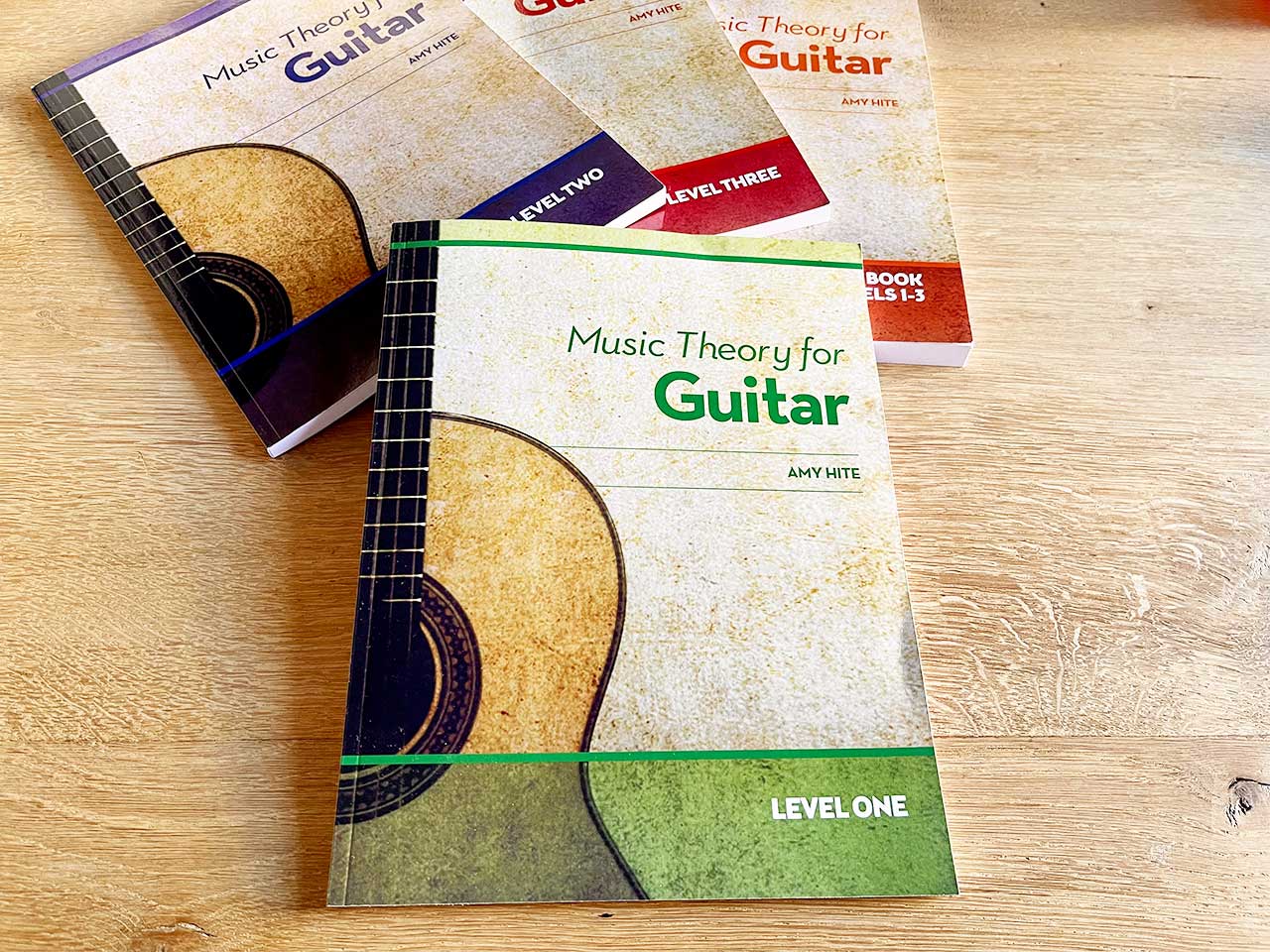
Music Theory for Guitar Workbook Series: Interview with Amy Hite – LEVEL ONE
Can you now tell us about the content of the Level 1 Volume?
Music Theory for Guitar: Level One covers the parts of the guitar, the music alphabet, names of open strings, understanding the music staff, different clefs, rhythm values and time signatures in 2/4 , 3/4, and 4/4 time, whole steps and half steps, and sharps and flats. It teaches the fundamentals of intervals by number only (not major or minor quite yet) and the C major, a natural minor, and a harmonic minor scales.
Each string on the guitar is given a different chapter of introduction where the student names the staff notes and frets on which they’re played, as well as identifies the note names from fretboard charts. I made a strong point to teach staff notation as well as fretboard note recognition. Once each new string is introduced, it is then put together with the other strings that have been learned, similar to the way students learn to play notes in a method book one string at a time. Level One covers all notes in first position (the first four frets) on all strings. Instructions and exercises are given to teach student on how to write the staff notes themselves. They learn to write all first position quarter notes, half notes, and whole notes, as well as rests.
I also included a chapter on basic signs and terms so that students learn about repeat signs, dynamics, and common music terminology. The book concludes with a comprehensive final exam so that they have a chance to review all of the learned material.
It’s the repetition that helps the learning stick with them for the long term.
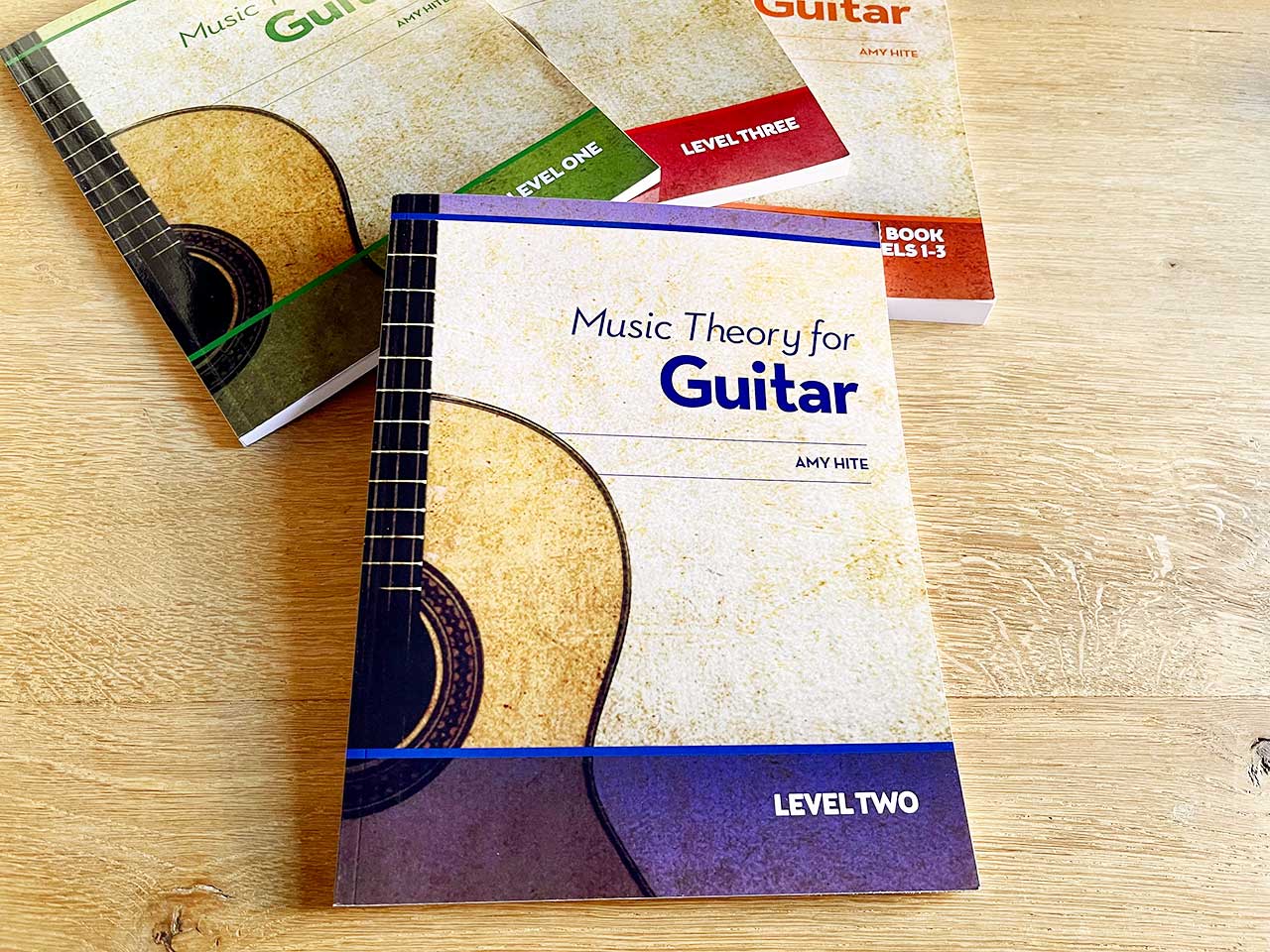
Music Theory for Guitar Workbook Series: Interview with Amy Hite – LEVEL TWO
What about the content of Level 2 Volume?
Level Two begins with a quick review of all notes in first position, including sharps and flats. It then adds notes through the fifth fret on all strings, using fretboard charts as well as staff notes. Students are asked not only to name the notes and frets on which they are played on, but the students also write note names directly onto fretboard charts so they can see the whole step – half step patterns clearly on the fretboard.
The next concept covered is the order of sharps and flats, and major and minor key signatures up to four sharps and one flat as these are the most common keys played on the guitar. Students then learn to identify and write these corresponding major, natural minor, and harmonic minor scales. They are always encouraged to PLAY these scales along the way!
As Level One taught intervals only by number, Level Two then covers major and perfect intervals, followed by major triads, cadences, and chord construction. After learning triads, students learn to identify and write chords the way they are often played on the guitar, both on the music staff and on fretboard charts.
The rhythms learned in Level One are expanded upon with the addition of dotted notes, eighth notes, and more complex time signatures such as cut time, 3/8, and 6/8 time. A lot of exercises are given to counting rhythms and students are encouraged to clap and count the rhythms!
Level One signs and terms are expanded upon in Level Two with new tempo indications, relative minor and parallel minor, and other common music terminology. Before the comprehensive Level Two Final Exam, you’ll find a Music Analysis chapter where two music examples are given and students answer questions of all aspects about the music.
This gives the students a chance to apply what they learned in previous chapters to real music.
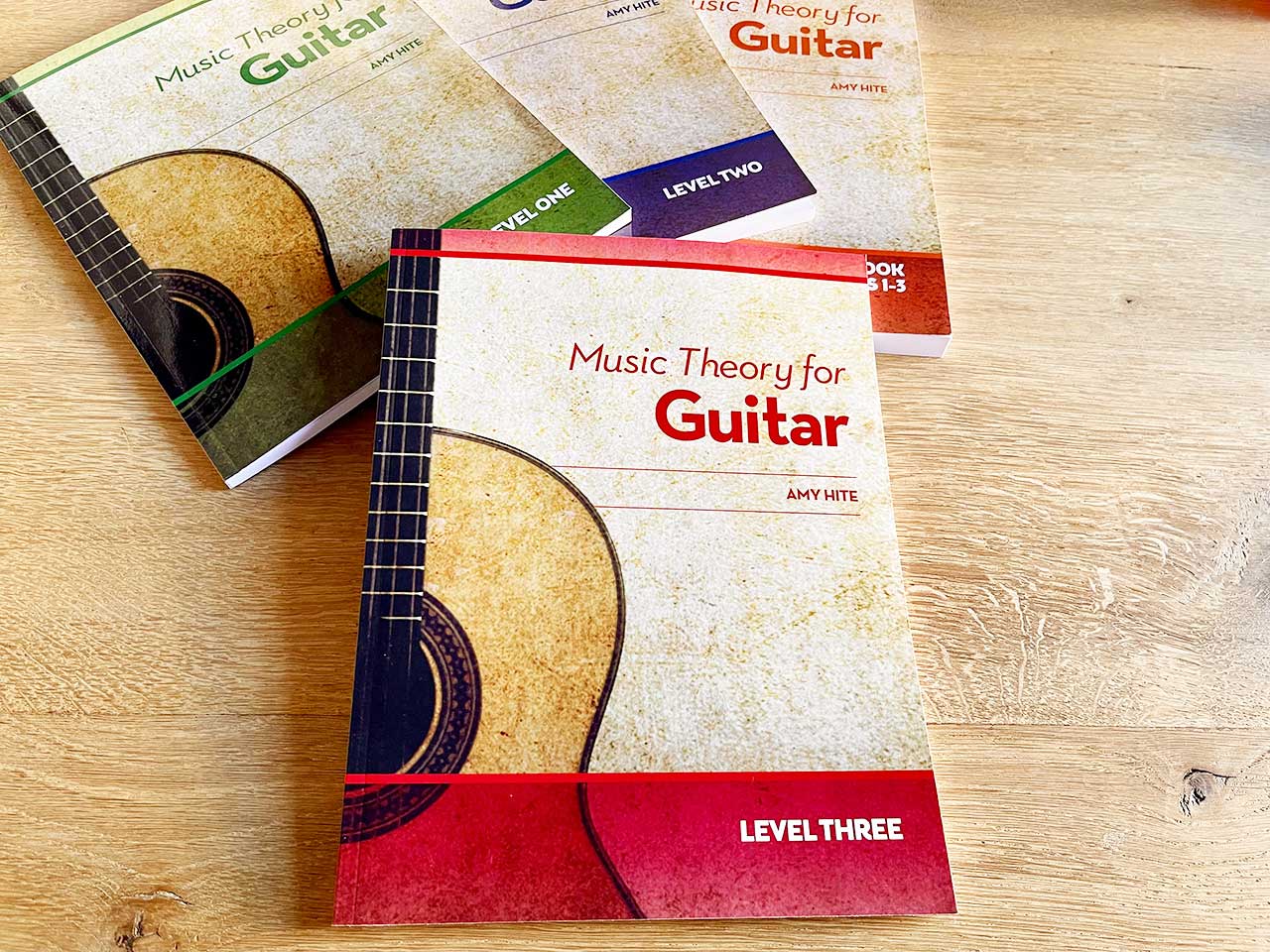
Music Theory for Guitar Workbook Series: Interview with Amy Hite – LEVEL THREE
What about the content of Level 3 Volume?
Level Three covers all fretboard notes through the twelfth fret extensively, with tips for finding patterns on the fretboard. All major and minor key signatures are taught as well as all major scales and the three forms of minor scales – natural, harmonic, and melodic. Minor intervals are added to the major and perfect intervals learned in Level Two (again, everything always builds upon itself – this is the key to incremental learning!).
Major and minor intervals, triads, and chords are taught in Level Three. Chords are given in notation as blocked chords as well as arpeggios and on fretboard charts, and identified and written in cadences. Students learn to write chord progressions in all keys and to transpose melodies and chord progressions. I included a chapter on barre chord theory as I feel this is important for guitarists to understand. It breaks apart root 5 and root 6 major, minor, and dominant 7th chords in barre form. I also included a chapter on the circle of 5ths as I feel this helps to tie it all together!
More complex rhythms are taught such as sixteenth notes and triplets. The signs and terms taught in previous levels are expanded upon, and the workbook concludes with a comprehensive music analysis example and final exam.
I also want to mention that there is a certificate in the back of each level workbook that certifies completion, along with some pages of blank staff paper for notes or extra practice.

Music Theory for Guitar Workbook Series: Interview with Amy Hite – ANSWER BOOK LEVELS 1-3
Below, in order to present extracts of the contents of the answer book, we have taken some pictures, so that the Internet users can see the clarity of your method.
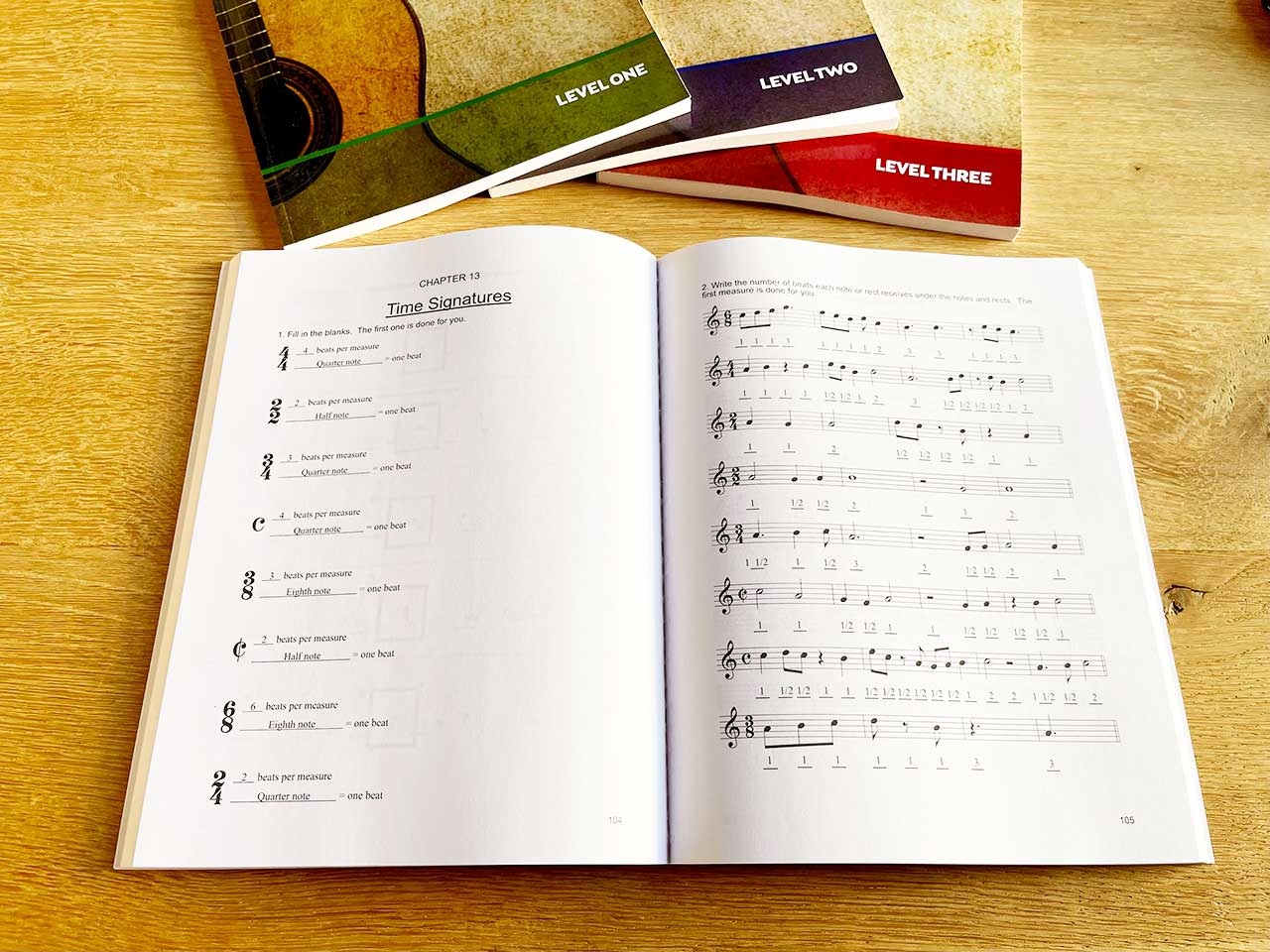
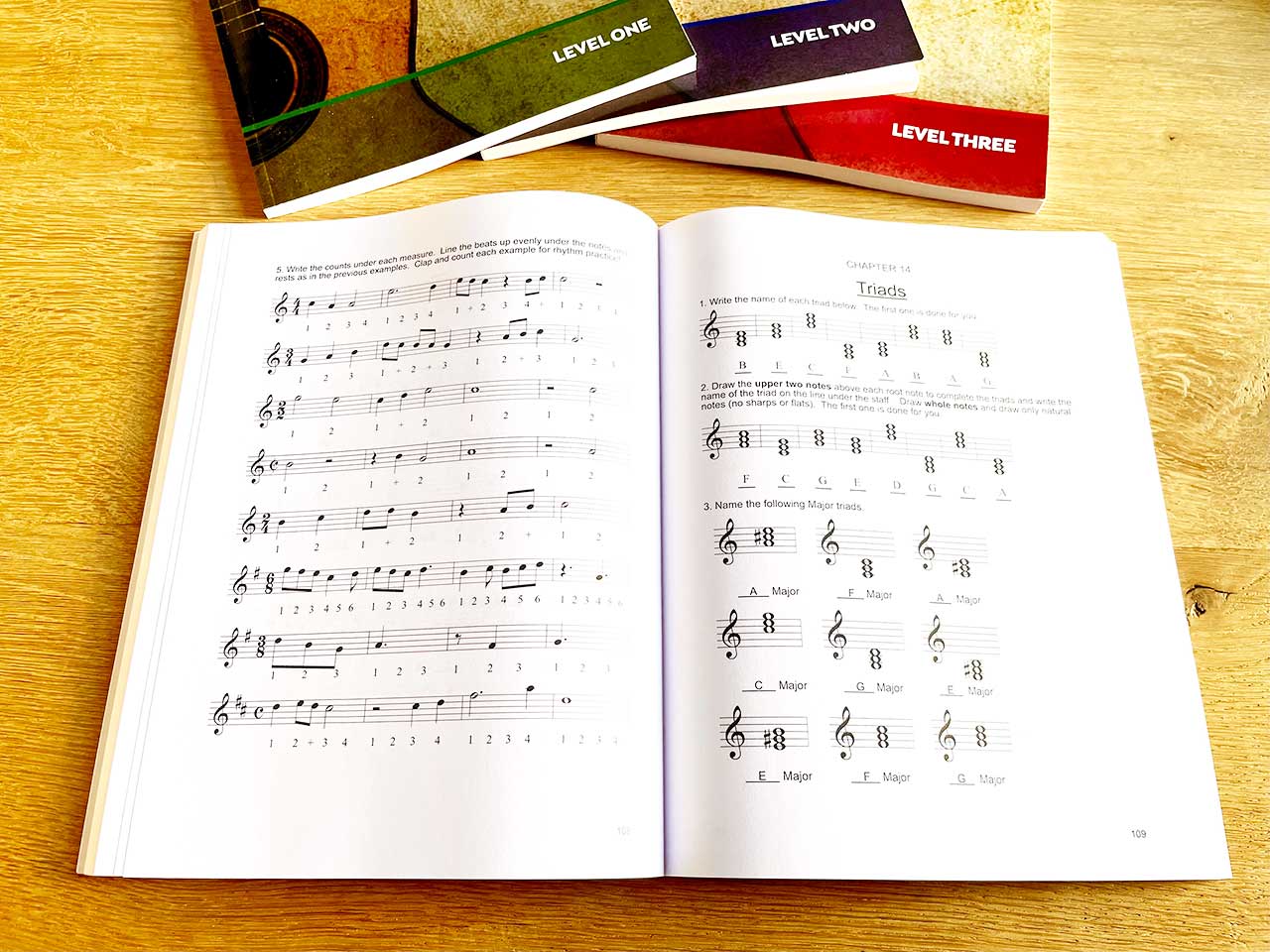
Music Theory for Guitar Workbook Series: Interview with Amy Hite
Thanks to you for all these clarifications, we want to mention one last point. We noticed that at the beginning of each volume, you have a page “Notes for the student” and “Notes for the teacher”. So your method series can also be used by guitar teachers to follow the evolution of their students’ theoretical knowledge. Is that right?
That’s correct. I think that teachers would find it immensely helpful to use the workbooks with their students.
It makes their job easier so they don’t have to remind their students over and over again where the notes are, how to count, and all the other things that make up teaching the guitar!
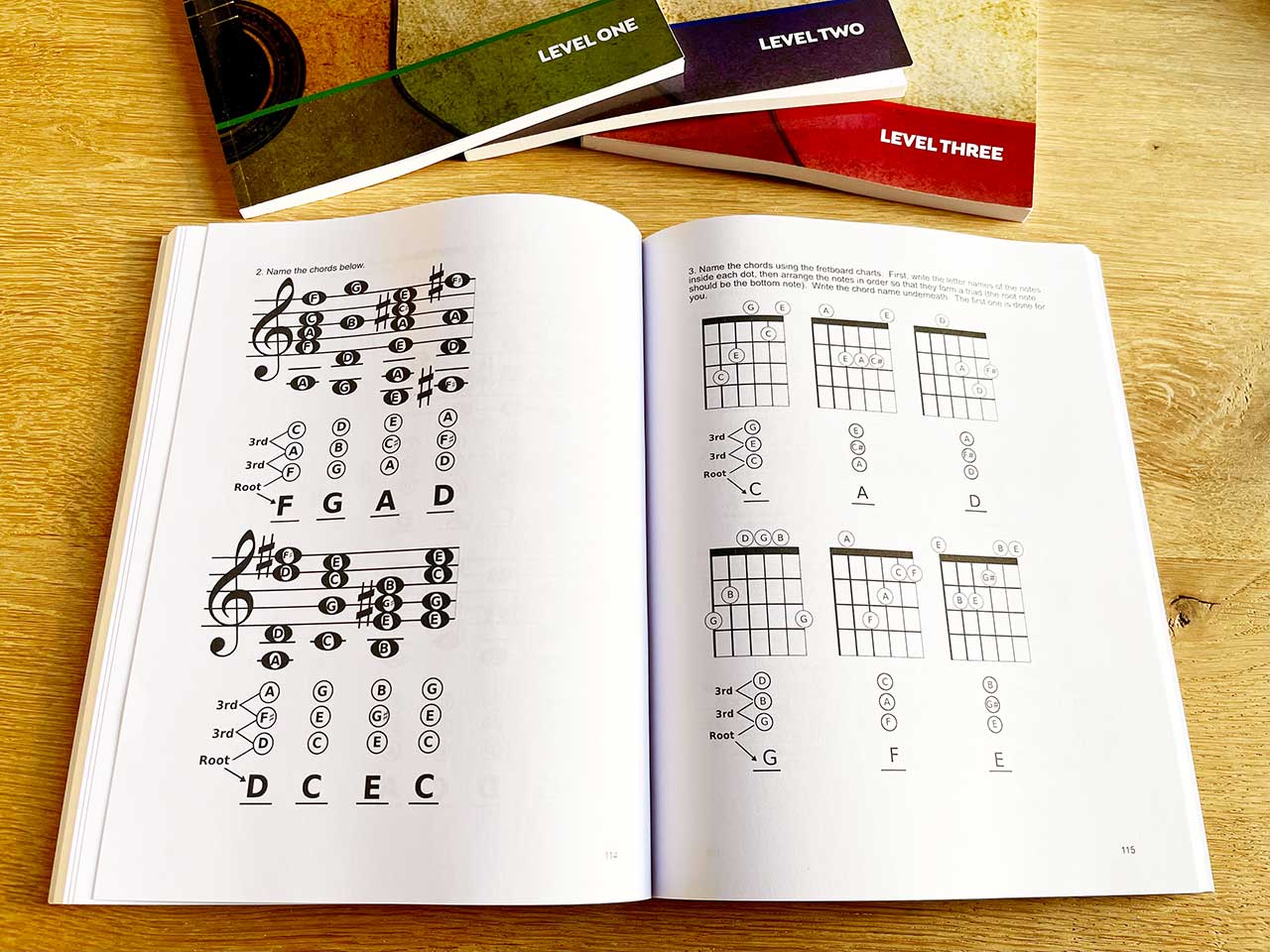
Music Theory for Guitar Workbook Series: Interview with Amy Hite
In conclusion, we warmly thank you for this interview. The whole Luthiers.com team is very happy to have been able to highlight your series of music theory methods for guitarists.
The different volumes are available for sale on Amazon, isn’t it ?
Yes, the books are available worldwide on Amazon.
The books are available for sale on Amazon US here:
Music Theory for Guitar Workbook Series on Amazon US
Les livres sont disponibles à la vente sur Amazon France ici :
Music Theory for Guitar Workbook Series sur Amazon France
Thank you so much for taking the time to do this interview. I’m happy to be given the opportunity to share the details about my books!
We invite you to visit her personal page on the website Luthiers.com here: https://luthiers.com/listing/music-theory-for-guitar-workbook-series-by-amy-hite/
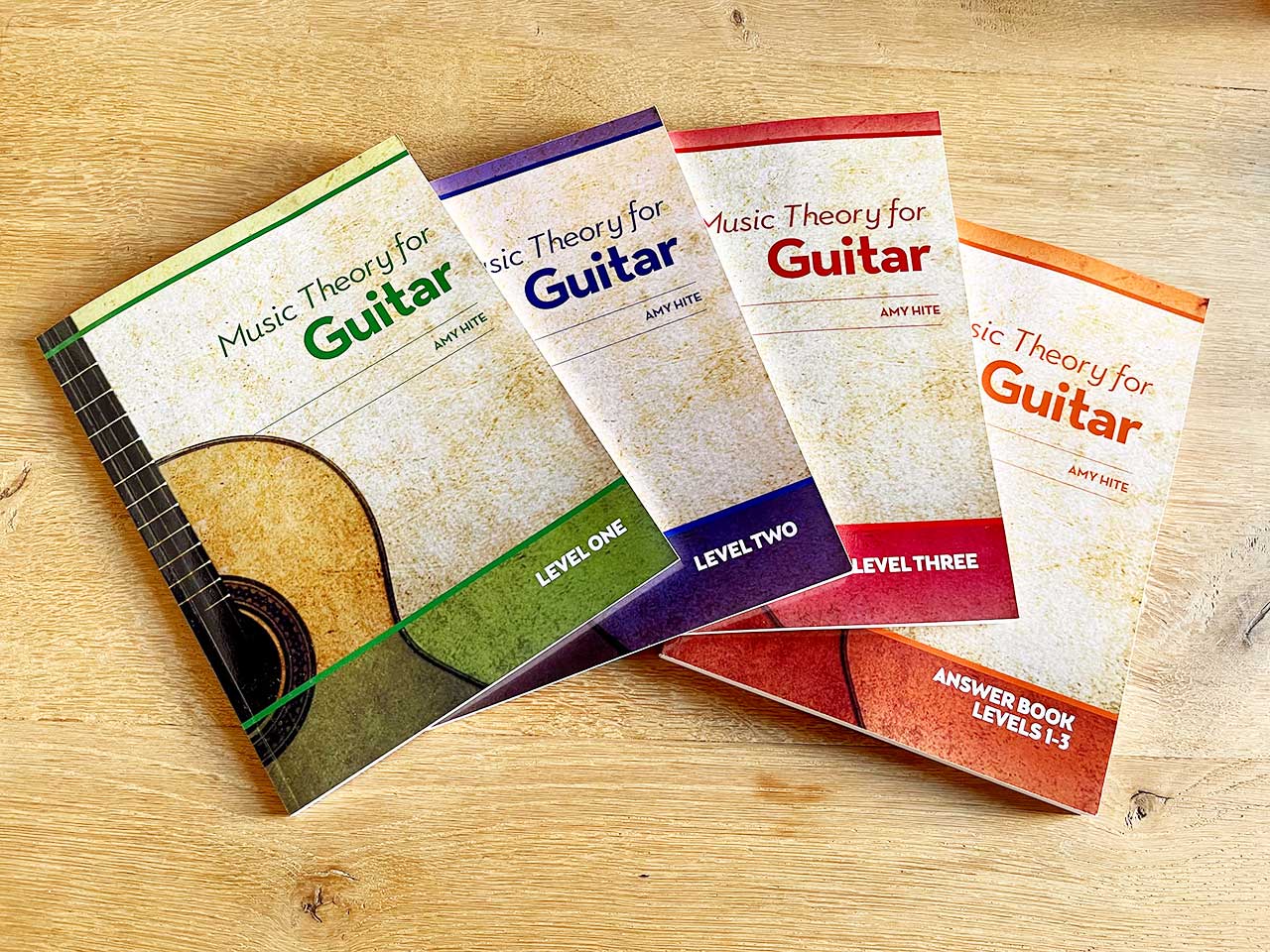
We can help you find your next luthier instrument!
In the coming weeks, as for others luthiers for plucked string instruments, luthiers for bowed string instruments, luthiers for other instruments, amps & effects makers, wood & supplies dealers, lutherie events, jobs, schools & teachers subscribers on our site, you will be able to follow our series of mini-interviews dedicated to the fascinating world of luthiers.
If you want some fun to discover our luthiers, also take a look and subscribe to our Instagram : @luthierscom and Facebook : @luthierscom accounts.
See you soon…
#luthiers
Subscribe to the newsletter!
Subscribe to our newsletter to follow all our news and those of our luthiers.
If you are passionate about the world of luthiers, join us!